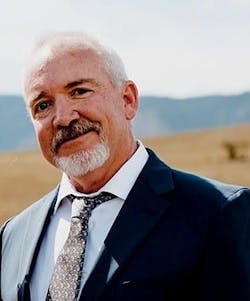SLC 2024 Preview: What it Means to be a Safety Leader
Didn’t get the promotion? Not a problem. You can still be a safety leader. How? Because leadership is not just a job title; it’s a mindset and philosophy that governs how you conduct yourself.
And when you start acting like a leader, other people will pay attention and listen.
Learning how to lead requires putting in the groundwork, says Lance Murray, safety manager at Mark Young Construction.
Murray should know. He has worked in EHS and risk management for the past 35 years. And, under his watch, Mark Young Construction was named one of EHS Today’s America’s Safest Companies of 2019.
Murray will be a speaker at the 2024 Safety Leadership Conference that’s taking place Aug. 26-28 in the greater Denver area. More information, including registration, can be found here. Below is a preview of what to expect from Murray’s presentation.
EHS Today: Your presentation is about being a better safety leader. What’s something people don’t realize about leadership?
LM: You don’t need to be in a leadership position to be a leader in your organization.
Leaders don’t have to be bold, brash and loud. Some of the finest examples I can think of were soft-spoken individuals who had the ability to develop relationships with those around them to create a shared vision.
What does it mean to be an effective safety leader, both for those who work in the safety department and those who don’t?
Think about people in your life who you have admired. People who have inspired you, people who challenged you, people who drew you out to be something that maybe you didn’t think you had in you. Consider their qualities, traits, mannerisms, etc. that drew you to them. Leaders don’t have to be bold, brash and loud. Some of the finest examples I can think of were soft-spoken individuals who had the ability to develop relationships with those around them to create a shared vision.
Safety is a people profession. I think many, if not most of us, got into this profession because we genuinely care about people. But to be effective safety leaders, we must be able to develop relationships with those around us. We don’t have to be close friends, but we do have to be friendly. With relationships comes trust and with trust comes respect, transparency, and a host of other attributes. Now you have something to build on, and you are creating a platform from which to speak and be heard.
How does the safety component fit into a company’s bigger picture?
We have all grown accustomed to the term “safety culture.” I think there is great benefit in creating a culture of safety within our organizations. However, I believe the greater outcome from a safety culture is how it impacts the organizational culture to the point of organizational culture and safety culture becoming one. In construction, the harder I work at attaining zero risk, the harder it is going to be to build a building. I always need to remember the goals of the organization while protecting people with those goals in mind.
What is one way that safety can be integrated into the company rather than a silo?
In building relationships with people within your organization, take a genuine interest in getting to know what their role is within the organization. You should do this with each person in every department within your organization. What makes them tick? How does their role affect the overall production of whatever it is the organization produces?
In construction, I’m talking with estimating, pre-construction, finance, HR, project coordinators, engineers, carpenters, finishers, superintendents, etc. because my goal is to integrate safety into all aspects of the project. If I don’t know what a project coordinator does for the organization, then I have failed at my goal because I don’t fully understand how the organization operates as a whole. The more I know about the organization, the more I can speak to topics outside of safety. This brings value to not only my own role, but the entire organization.
How can safety professionals get a seat at the executive table? More importantly, how can safety professionals make sure they are heard by executives?
This really depends on the organization and how it is structured, what your relationships are like with executives, who the top safety person reports to, etc. As the safety manager within my organization, there is no other safety personnel above me. I report to the president, but I do not attend top executive meetings. There really is no need to. My relationship with top executives offers me the opportunities I need to speak about safety, risk, security, etc. with everyone. But if I worked in a large corporate setting, or in a situation where I had no voice, or executives were closed off to anyone other than other executives, then it would likely be a different situation.
I come back again to relationships with all people at all levels. That is your foot in the door. Practice your elevator speech because time is important and just keep adding value to the organization. Regularly communicate your vision in your interactions with executive staff and emphasize how it will positively affect the organization. Lastly, spend time in your own head creating responses for the many hard questions that may come your way. A wise person once said, “Don’t come to me with a problem that you have not already developed an answer or solution to.”
It seems like executives fear that safety is a cost center, a burden, and something else to do. But statistics show that isn’t the case. How do you counter any falsehoods or misunderstandings about safety?
Always remember your employer is in business to make a profit. That does not make them bad people. That is just capitalism. Portions of the profits go to pay employee salaries, benefits, purchase materials, supplies, insurance, etc. Without profit, doors close, and nobody has a job. As safety professionals, we cannot lose sight of that. If my work is not helping my employer turn a profit, then I should not there. Period.
My role as a safety professional within the organization should always be the "prevention of injuries or property damage." I cannot effectively accomplish that role if I am only out on the floor or in the field preaching OSHA regulations and figuratively beating people over the head with safety. That is a cost center because it is not going to be fully effective at preventing injuries. Prove the value of safety by communicating results through the relationships you have built, data reporting, water cooler and hallway conversations, and the reputations you create. They will, in turn, be communicated by other people.
When I first went to work for my current employer, there were clients that would not use my company to provide services because of our safety record. Today, we are producing millions and millions of dollars annually in revenue because we brought our safety program to a better place. Safety is now recognized as a profit center instead of a cost center.
What do safety professionals need to better understand about the words they use and the ways they communicate with others?
Know your audience and the language they speak. C-suite people are just that. People. However, from a business and profit perspective, I need to speak in a language they can relate to—and that promotes safety into the business structure. If I tell our CEO, president and project managers that our TRIR is 0.7, that means we just qualified to perform more work for more clients and generate more profits, company growth, etc.
On the other side of the spectrum are our field personnel. When I’m engaged with them, my language has to adjust to one they can relate to. For instance, if I walk out in the field with great enthusiasm and tell Bill, a concrete finisher, that our TRIR is 0.7, he is going to look at me a bit puzzled. Not wanting to dampen my enthusiasm, he’ll respond with, “I’m not sure what the heck you’re talking about but if you’re happy, I’m happy for you!” On the other hand, if I strike up a conversation with Bill about a near-miss that happened below some scaffolding on the project, I just gave Bill some information that he is genuinely interested in because he walks by that scaffold every day.
You need to speak data and statistics to some and tell stories to others.
What’s one thing you hope attendees take away from your upcoming session at the Safety Leadership Conference?
First, I would hope people would walk away with a little different perspective on safety and how it interacts with the organization as a whole. You can’t just be a safety professional. You must be a fiber in the fabric of the organization. Too often, we set ourselves apart as the single most important thing in the organization and create our own island. And then we step back and ask why we feel so isolated. We’ve lost sight of the meaning of the word "business."
Secondly, recognize where your existing safety culture is within your organization and break down the stages of safety maturity. It’s hard to map your future without knowing where you came from and where you are now. Create the vision, communicate the vision and move the vision forward.
About the Author
Nicole Stempak
Nicole Stempak is managing editor of EHS Today and conference content manager of the Safety Leadership Conference.


